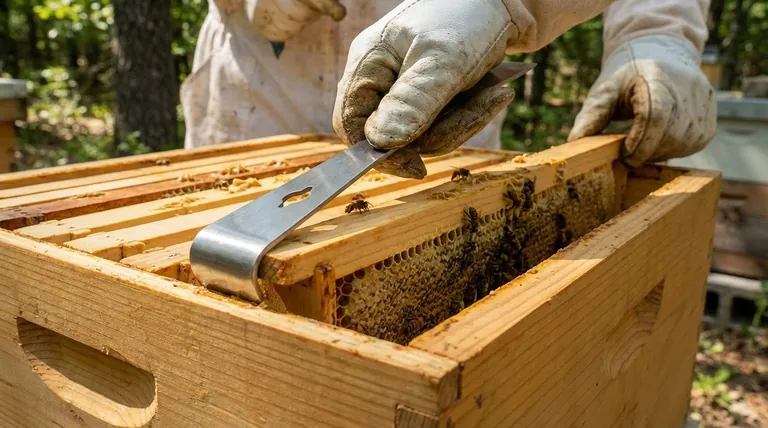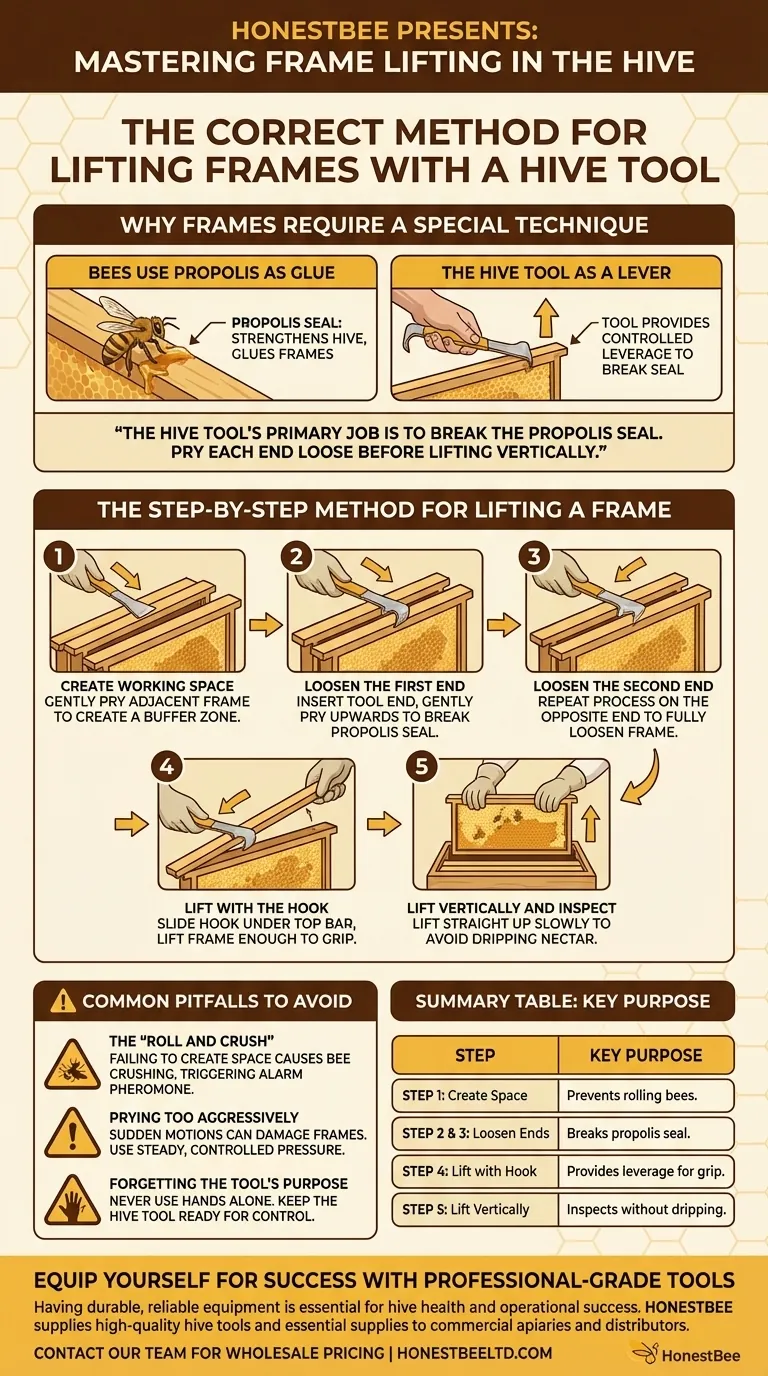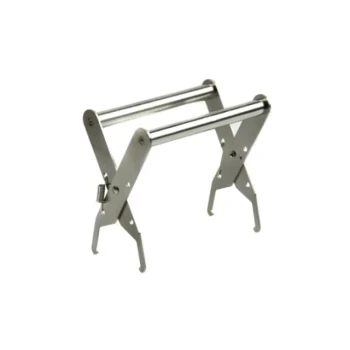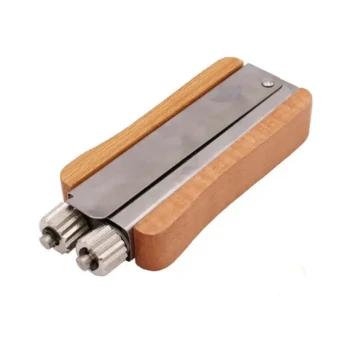The correct method for lifting a frame involves using the hook end of your hive tool to pry up one end of the frame, then the other, before lifting it out. You slide the hook under the frame's top bar and use it as a lever to gently break the propolis seal that glues the frame in place. This two-step prying action prevents you from rolling and crushing bees between adjacent frames.
The hive tool isn't just for lifting; its primary job is to break the propolis seal that glues frames together. The correct technique involves prying each end of the frame loose before attempting to lift it vertically, ensuring the safety of the bees and the integrity of the comb.

Why Frames Require a Special Technique
To understand how to lift a frame, you must first understand why it is stuck. The answer lies in a substance the bees produce called propolis.
Bees Use Propolis as Glue
Bees create propolis, a sticky, resinous mixture, to seal small gaps and cracks within the hive. They use it to reinforce the structure and protect it from weather and predators.
Unfortunately for the beekeeper, bees also use propolis to glue down frame ends and stick frames together, making them difficult to remove.
The Hive Tool as a Lever
Your hive tool is designed primarily as a lever to overcome the strength of this propolis seal. Attempting to lift a frame with your bare hands will fail and likely result in jerky movements that agitate the colony. The tool provides the leverage needed for a smooth, controlled separation.
The Step-by-Step Method for Lifting a Frame
A calm, methodical approach is essential. Each step is designed to minimize disturbance and prevent harm to the bees.
Step 1: Create Working Space
Before targeting a specific frame, use the flat end of your hive tool to gently pry an adjacent frame a few millimeters away. This creates a crucial buffer zone that prevents you from rolling bees when you lift your desired frame.
Step 2: Loosen the First End
Insert the hooked or flat end of your hive tool into the space between one end of the frame's top bar and the hive body wall. Gently pry upwards, just enough to break the propolis seal. You should hear a slight crackling sound.
Step 3: Loosen the Second End
Move to the opposite end of the same frame and repeat the process. Pry it up just enough to break the seal on that side. The frame is now loose and ready to be lifted.
Step 4: Lift with the Hook
Slide the hook end of your tool under one side of the top bar. Use it to lift the frame about an inch, just high enough to get a firm grip on the top bar with your fingers.
Step 5: Lift Vertically and Inspect
Grasping both ends of the top bar, lift the frame straight up and out of the hive. Always move slowly and deliberately, keeping the frame vertical to avoid having fresh nectar drip into the hive.
Common Pitfalls to Avoid
Mistakes during frame removal are common for beginners and can lead to an agitated colony or a damaged queen.
The "Roll and Crush"
The most serious error is failing to create space between frames before lifting. When you pry a frame directly against its neighbor, you invariably roll and crush the bees between them. This releases an alarm pheromone that can trigger a defensive response from the entire colony.
Prying Too Aggressively
Do not use sudden, jerky motions. Propolis can be brittle, and aggressive prying can damage the wooden frame or the hive body. Work slowly, applying steady pressure until the seal breaks.
Forgetting the Tool's Purpose
Never try to muscle a frame out with your hands. The hive tool is your most essential piece of equipment during an inspection. Keeping it in hand allows you to address any resistance you encounter immediately and with control.
Applying This to Your Inspection
Your goal during the inspection will dictate how you apply this technique.
- If your primary focus is a quick spot check: Loosen and lift just one or two frames in the center to check for brood patterns or food stores.
- If your primary focus is a full hive inspection: Start by removing an outer frame (often frame #2 or #9) to create ample working space for manipulating the rest of the frames.
- If you encounter extreme resistance: Stop prying. Use your smoker to gently move bees away from the stuck area, then use the flat end of the tool to scrape away excess propolis from the contact points before trying again.
Mastering this simple technique is a fundamental step toward becoming a calm and confident beekeeper.
Summary Table:
| Step | Action | Key Purpose |
|---|---|---|
| 1 | Create Space | Prevents rolling and crushing bees between frames. |
| 2 | Loosen First End | Breaks the propolis seal on one side of the frame. |
| 3 | Loosen Second End | Breaks the seal on the opposite side. |
| 4 | Lift with Hook | Provides leverage to grip the frame with your fingers. |
| 5 | Lift Vertically | Inspects the frame without dripping nectar into the hive. |
Equip yourself for success with professional-grade tools from HONESTBEE.
Just as the correct technique is vital for a calm hive inspection, having durable, reliable equipment is essential for the health of your bees and the success of your operation. HONESTBEE supplies commercial apiaries and beekeeping equipment distributors with high-quality hive tools and other essential supplies through our wholesale-focused operations.
Let us help you build a more efficient and productive beekeeping business. Contact our team today to discuss your equipment needs and wholesale pricing.
Visual Guide

Related Products
- Professional Stainless Steel Pry-Bar Hive Tool
- HONESTBEE Advanced Ergonomic Stainless Steel Hive Tool for Beekeeping
- HONESTBEE Premium Italian Style Hive Tool with Hardwood Handle
- Multi-Function Plier-Style Frame Grip Hive Tool
- HONESTBEE Professional Long Handled Hive Tool with Precision Cutting Blade
People Also Ask
- Why is it recommended to have multiple hive tools on hand? Essential Tips for Efficient Beekeeping
- What are the different types of hive tools available? Choose the Right Tool for Your Apiary
- What is a standard hive tool and what are its features? The Essential Multi-Function Tool for Beekeepers
- What equipment and implements are needed by beekeepers besides the hives? Build Your Essential Beekeeping Toolkit
- What types of hive tools are available for beekeepers? Choose the Right Lever for Your Apiary



















